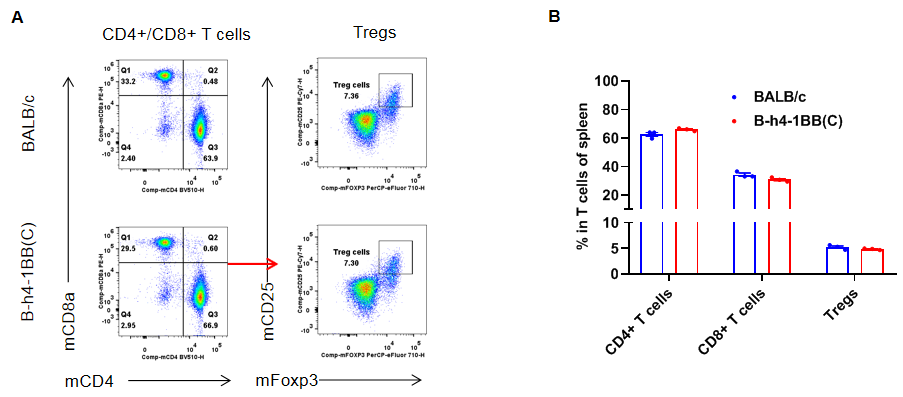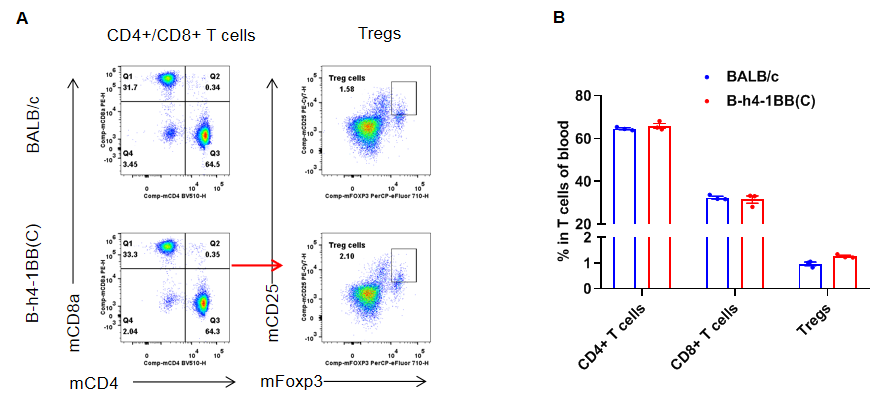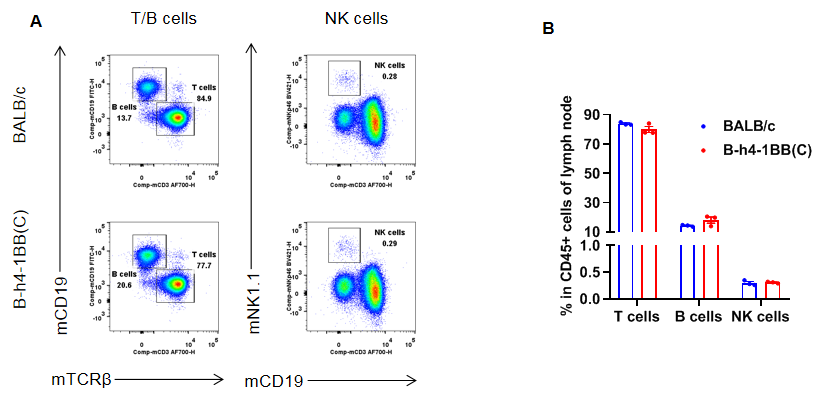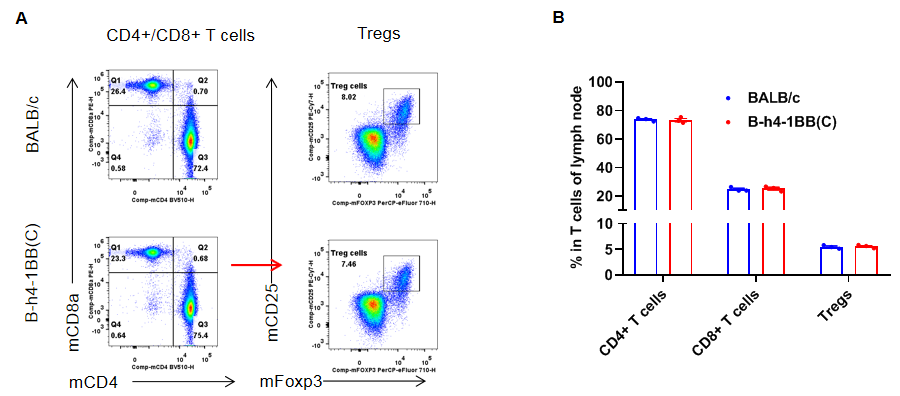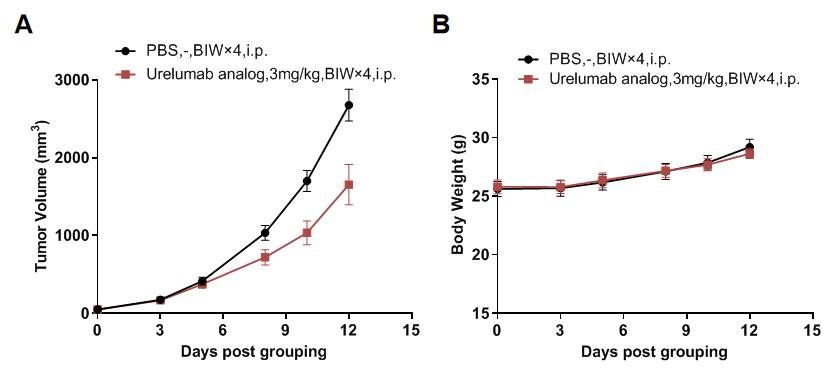 Protein expression analysis
Protein expression analysis
Strain specific 4-1BB protein expression analysis in BALB/c mice and homozygous B-h4-1BB mice(C) by flow cytometry. Splenocytes were collected from wild type BALB/c mice (+/+) and homozygous B-h4-1BB mice(C) (H/H) that stimulated with or without anti-CD3ε treatment in vivo, and analyzed by flow cytometry with species-specific anti-4-1BB antibodies. Mouse 4-1BB was detectable in different T cell subtypes of BALB/c mice, while human 4-1BB was exclusively detectable in T cell subtypes of B-h4-1BB mice(C).
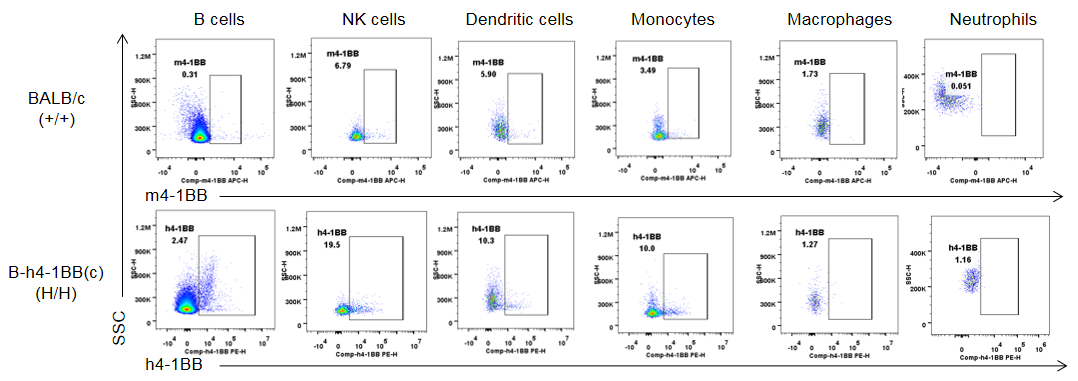
Strain specific 4-1BB protein expression analysis in BALB/c mice and homozygous B-h4-1BB mice(C) by flow cytometry. Splenocytes were collected from wild type BALB/c mice (+/+) and homozygous B-h4-1BB mice(C) (H/H), and analyzed by flow cytometry with species-specific anti-4-1BB antibodies. Mouse 4-1BB was detectable in B cells, NK cells, dendritic cells and monocytes of BALB/c mice but not in macrophages and neutrophils. While human 4-1BB was exclusively detectable in B cells, NK cells, dendritic cells and monocytes of B-h4-1BB mice(C) but not in macrophages and neutrophils.
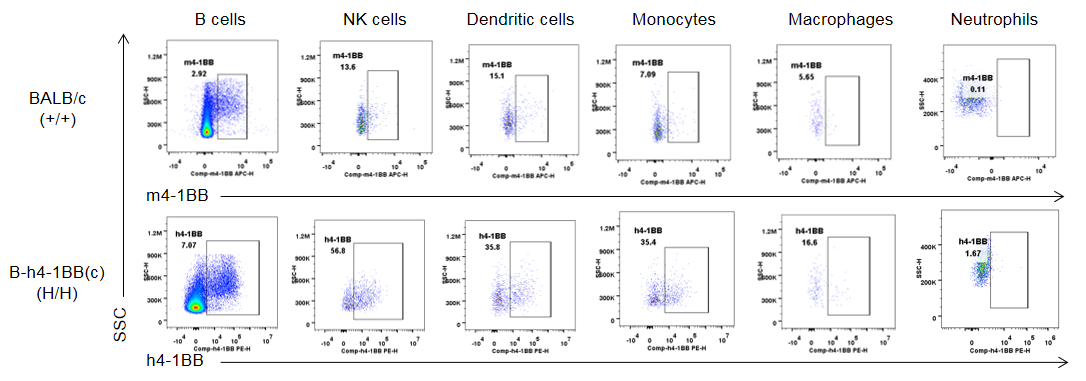
Strain specific 4-1BB protein expression analysis in BALB/c mice and homozygous B-h4-1BB mice(C) by flow cytometry. Splenocytes were collected from wild type BALB/c mice (+/+) and homozygous B-h4-1BB mice(C) (H/H) that stimulated with anti-CD3ε in vivo, and analyzed by flow cytometry with species-specific anti-4-1BB antibodies. Mouse 4-1BB was detectable in B cells, NK cells, dendritic cells and monocytes of BALB/c mice but not in macrophages and neutrophils. While human 4-1BB was exclusively detectable in B cells, NK cells, dendritic cells and monocytes of B-h4-1BB mice(C) but not in macrophages and neutrophils.
 Analysis of leukocytes cell subpopulation in spleen
Analysis of leukocytes cell subpopulation in spleen
Analysis of spleen leukocyte subpopulations by flow cytometry. Splenocytes were isolated from female BALB/c and B-h4-1BB mice(C) (n=3, 8-week-old). Flow cytometry analysis of the splenocytes was performed to assess leukocyte subpopulations. A. Representative FACS plots. Single live cells were gated for the CD45+ population and used for further analysis as indicated here. B. Results of FACS analysis. Percent of T cells, B cells, NK cells, dendritic cells, neutrophils, monocytes and macrophages in homozygous B-h4-1BB mice(C) were similar to those in the BALB/c mice, demonstrating that 4-1BB humanized does not change the overall development, differentiation or distribution of these cell types in spleen. Values are expressed as mean ± SEM.
 Analysis of T cell subpopulation in spleen
Analysis of T cell subpopulation in spleen
Analysis of spleen T cell subpopulations by flow cytometry. Splenocytes were isolated from female BALB/c and B-h4-1BB mice(C) (n=3, 8-week-old). Flow cytometry analysis of the splenocytes was performed to assess leukocyte subpopulations. A. Representative FACS plots. Single live CD45+ cells were gated for TCRβ+ T cell population and used for further analysis as indicated here. B. Results of FACS analysis. The percent of CD8+ T cells, CD4+ T cells, and Tregs in homozygous B-h4-1BB mice(C) were similar to those in the BALB/c mice, demonstrating that introduction of h4-1BB in place of its mouse counterpart does not change the overall development, differentiation or distribution of these T cell subtypes in spleen. Values are expressed as mean ± SEM.
 Analysis of leukocytes cell subpopulation in blood
Analysis of leukocytes cell subpopulation in blood
Analysis of blood leukocyte subpopulations by flow cytometry. Blood cells were isolated from female BALB/c and B-h4-1BB mice(C) (n=3, 8-week-old). Flow cytometry analysis of the blood was performed to assess leukocyte subpopulations. A. Representative FACS plots. Single live cells were gated for the CD45+ population and used for further analysis as indicated here. B. Results of FACS analysis. Percent of T cells, B cells, NK cells, dendritic cells, neutrophils, monocytes and macrophages in homozygous B-h4-1BB mice(C) were similar to those in the BALB/c mice, demonstrating that 4-1BB humanized does not change the overall development, differentiation or distribution of these cell types in blood. Values are expressed as mean ± SEM.
 Analysis of T cell subpopulation in blood
Analysis of T cell subpopulation in blood
Analysis of blood T cell subpopulations by flow cytometry. Blood were isolated from female BALB/c and B-h4-1BB mice(C)(n=3, 8-week-old). Flow cytometry analysis of the blood was performed to assess leukocyte subpopulations. A. Representative FACS plots. Single live CD45+ cells were gated for TCRβ+ T cell population and used for further analysis as indicated here. B. Results of FACS analysis. The percent of CD8+ T cells, CD4+ T cells, and Tregs in homozygous B-h4-1BB mice(C) were similar to those in the BALB/c mice, demonstrating that introduction of h4-1BB in place of its mouse counterpart does not change the overall development, differentiation or distribution of these T cell subtypes in blood. Values are expressed as mean ± SEM.
 Analysis of leukocytes cell subpopulation in lymph node
Analysis of leukocytes cell subpopulation in lymph node
Analysis of lymph node leukocyte subpopulations by flow cytometry. Lymph node cells were isolated from female BALB/c and B-h4-1BB mice(C) (n=3, 8-week-old). Flow cytometry analysis of the lymph node was performed to assess leukocyte subpopulations. A. Representative FACS plots. Single live cells were gated for the CD45+ population and used for further analysis as indicated here. B. Results of FACS analysis. Percent of T cells, B cells, and NK cells in homozygous B-h4-1BB mice(C) were similar to those in the BALB/c mice, demonstrating that 4-1BB humanized does not change the overall development, differentiation or distribution of these cell types in lymph node. Values are expressed as mean ± SEM.
 Analysis of T cell subpopulation in lymph node
Analysis of T cell subpopulation in lymph node
Analysis of lymph node T cell subpopulations by flow cytometry. Lymph node were isolated from female BALB/c and B-h4-1BB mice(C) (n=3, 8-week-old). Flow cytometry analysis of the lymph node was performed to assess leukocyte subpopulations. A. Representative FACS plots. Single live CD45+ cells were gated for TCRβ+ T cell population and used for further analysis as indicated here. B. Results of FACS analysis. The percent of CD8+ T cells, CD4+ T cells, and Tregs in homozygous B-h4-1BB mice(C) were similar to those in the BALB/c mice, demonstrating that introduction of h4-1BB in place of its mouse counterpart does not change the overall development, differentiation or distribution of these T cell subtypes in lymph node. Values are expressed as mean ± SEM.







